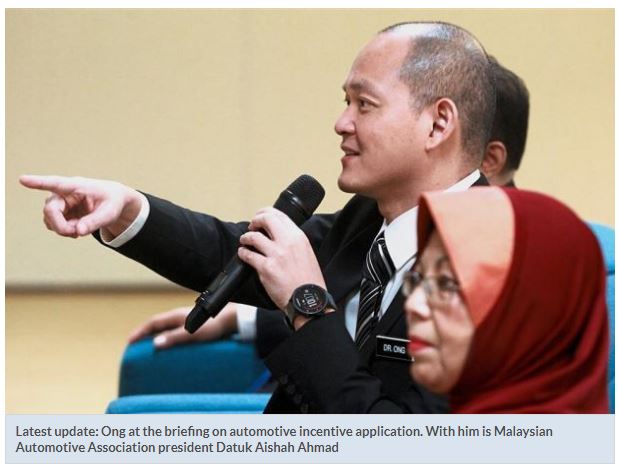Malaysia: Lower price for cars?
KUALA LUMPUR: The International Trade and Industry Ministry (Miti) might be looking towards a reduction in excise duties for vehicles, which will, in turn, result in a reduction in car prices.
While there may be less revenue for the government from a reduction in excise duties, this can be compensated by a larger sales volume.
Deputy International Trade and Industry Minister Ong Kian Ming said this would be a win-win situation for Malaysians, industry players and the government.
“Of course, there is a cost-benefit involved here in the sense that you have more tax reduction in the excise duty. The government may collect less per unit, but whatever revenue lost by the Finance Ministry can be regained by the increase in the sales volume because car prices would be lower.
“The original equipment manufacturers (OEMs) get to sell more cars, consumers get to benefit from lower car prices and the Finance Ministry gets to benefit as well, when it gets to collect more excise tax as a whole because of increased volumes. This is something we want to work towards for all car models,” he told a press conference.
Ong added that industry players would give their estimates on their expected increase in the sales volume as a result of more exemptions in the excise duty.
He said local suppliers and vendors to the OEMs would be able to benefit more from higher volumes when there are more completely-knocked-down (CKD) activities.
The government wants to encourage the development of the local vendor ecosystem, which is also why the Industrial Linkage Programme (ILP) and customised incentives are in place.
The ILP is an incentive programme that seeks to encourage local OEMs to procure locally produced parts and components and to build the capacity of local suppliers.
OEMs can also apply for customised incentives for energy-efficient vehicles (EEV) for a higher ILP excise duty reduction.
“The local activity in the automotive sector would be very little if most of the units brought in are completely-built-up (CBU),” Ong said.
An automotive industry observer said this would likely benefit local manufacturers as compared to imported cars, as this would help CKD programmes in the country.
He said this would help lower car prices, on top of the reduction in prices since the transition from the zero-rated goods and services tax to the sales and service tax, where the likes of Perodua, Mazda and Toyota models saw price drops.
An analyst said details on the excise duty, ILP and customised incentives are still cloudy, but is of the opinion that further incentives are likely to be given for EEV.
“This is still a very sensitive topic. We prefer to wait for the National Automotive Policy review that will be released by the end of this quarter before we make any conclusions,” said the analyst.
Another analyst is of the view that the reduction in the excise duty would not impact sales volume or the government’s coffers, and even if it did, it might be hardly felt.
“The prices of Perodua and Proton might not reduce that much from this, but it would be more favourable for the Japanese brands,” he said.
Ong was speaking to reporters after announcing that the Automotive Business Development Committee (ABDC), which is chaired by Miti, will increase the frequency of its monthly meetings from once to twice a month to reduce the turnaround time of processing automotive incentive applications.
The dates have already been identified and it will be circulated to the automotive industry.
This was decided in a meeting between Miti and the Malaysian Automotive Association (MAA) on Wednesday.
It was also agreed that Miti would come up with an enhanced process flow and client charter of ABDC to ensure timeliness and greater transparency of the process in evaluating incentive applications.
The cost and benefit analysis (CBA) for EEV customised incentive applications will also be reviewed to ensure a fair and equitable evaluation process.
Ong said the CBA for the ILP, which is done by the Malaysia Automotive, Robotics and IoT Institute or MARii, is quite complicated and needs to be more transparent, explained in greater detail and updated to take into account new conditions in the car manufacturing and automotive sector.
“It’s a process of refining and updating the CBA. We want to make it as clear as possible to the industry players, so that the ABDC process can be sped up and the issues that have been raised by MAA in terms of delays that had occurred last year would be minimised, moving forward,” said Ong.
He added that it would take about two days to process and approve the ILP at the ABDC stage before a letter is sent to the Finance Ministry. As for customised incentives, it will take about a week.
MAA president Datuk Aishah Ahmad, who was also present yesterday, said the association hoped that request for incentives to get pricing approvals would be sped up in future.
“We were really waiting for many models to get the pricing approvals last year. Stocks have built up and there are some members who have 12,000 units in the yard.
“Moving forward, I’m sure all these issues that we had previously faced would be solved,” she said.
Aishah told a press conference on Jan 16 that the Finance Ministry had channelled decision-making processes related to the ILP to the ABDC and claimed that the ministry had been delaying its approvals for new car models’ pricing, even after the ABDC had decided on the incentives.
Source: https://www.thestar.com.my/business/business-news/2019/01/25/lower-excise-duty-for-cars/#wDhlXJjjJrPdXegl.99


 Thailand
Thailand




